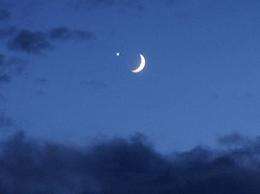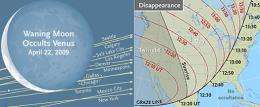Venus Disappears during Meteor Shower

Picture this: It's 4:30 in the morning. You're up and out before the sun. Steam rises from your coffee cup, floating up to the sky where a silent meteor streaks through a crowd of stars. A few minutes later it happens again, and again. A meteor shower is underway.
One of the streaks leads to the eastern horizon. There, just above the tree line, Venus and the crescent Moon hover side by side, so close together they almost seem to touch. Suddenly, Venus wavers, winks, and disappears.
All of this is about to happen--for real.
On Wednesday morning, April 22nd, Earth will pass through a stream of comet dust, giving rise to the annual Lyrid meteor shower. At the same time, the crescent Moon and Venus will converge for a close encounter in the eastern sky. Viewed from some parts of the world, the Moon will pass directly in front of Venus, causing Venus to vanish.
The source of the meteor shower is Comet Thatcher. Every year in late April, Earth passes through the comet's trail of debris. Flakes of comet dust, most no bigger than grains of sand, strike Earth's atmosphere traveling 110,000 mph and disintegrate as fast streaks of light. A typical Lyrid shower produces 10 to 20 meteors per hour over the northern hemisphere, not an intense display. Occasionally, however, Earth passes through a dense region of the comet's tail and rates increase five- to ten-fold. In 1982, observers counted 90 Lyrids per hour. Because Thatcher's tail has never been mapped in detail, the outbursts are unpredictable and could happen again at any time. The probabilities are highest during the dark hours before sunrise on April 22nd.
The Moon-Venus conjunction is pure coincidence. It has nothing to do with the Lyrid display other than insurance. Even if the shower fizzles, the sight of a 9% crescent Moon located so close to brilliant Venus is guaranteed to make your day.
Most observers will see only a close gathering of the two bodies. People in western parts of North America are favored with more--a full-blown eclipse or "occultation." Around 5 a.m. Pacific Daylight Time, Venus will disappear behind the mountainous rim of the Moon and reappear 60 to 90 minutes later.

Do not worry if the sun rises during the occultation, because Venus and the Moon are bright enough to see in broad daylight. Locate the pair before sunrise, so you know where they are, then follow them up the brightening sky using binoculars or naked eyes. Some people say Venus and the Moon are most beautiful when surrounded by morning blue.
On Wednesday morning, April 22nd, you can see for yourself.
Source: Science@NASA, by Dr. Tony Phillips





















